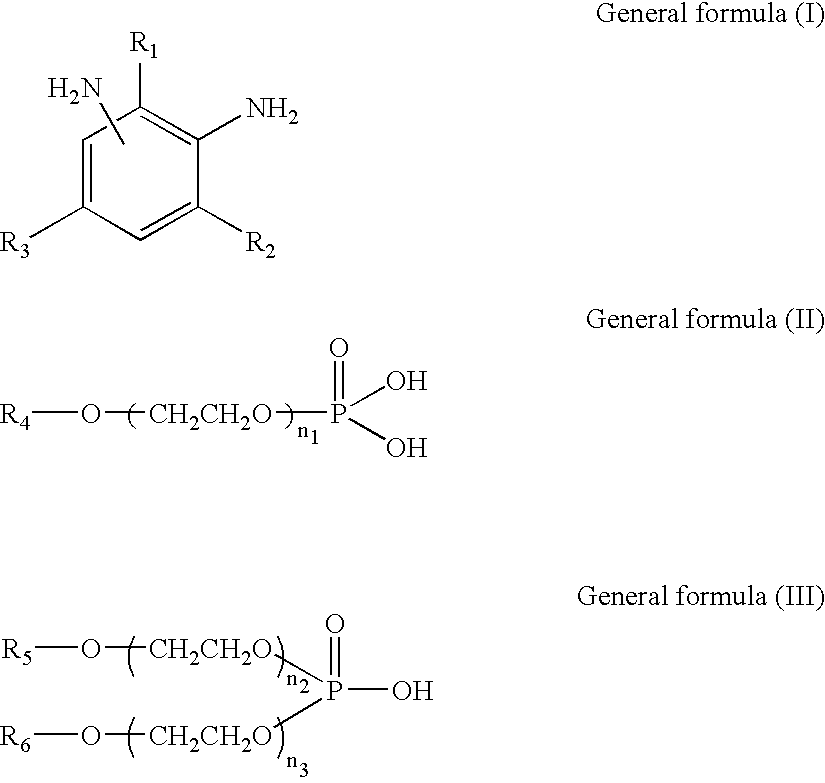Transparent molded objects, optical member, plastic lens, and processes for producing these
- Summary
- Abstract
- Description
- Claims
- Application Information
AI Technical Summary
Benefits of technology
Problems solved by technology
Method used
Image
Examples
embodiment 1
[0203] To 100 weight parts of isocyanate terminal prepolymer (denoted as ITP-1 in Table 1) having an isocyanate group content of 13 percent and comprised of polytetramethylene glycol with an average molecular weight of 400 and 4,4'-methylenebis(cyclohexyl isocyanate), 0.024 weight part of monobutoxyethyl acid phosphate (denoted as MBP in Table 1) and 0.036 weight part of di(butoxyethyl) acid phosphate (denoted as DBP in Table 1) were added in advance. The mixture was uniformly mixed and defoamed. Next, 25.5 weight parts of a mixture (denoted as DETDA in Table 1) of 3,5-diethyl-2,4-toluene diamine and 3,5-diethyl-2,6-toluene diamine were uniformly admixed at 60-70.degree. C. and stirred in a short time at high speed. Immediately after stirring, the mixture was poured into a lens-forming glass mold and polymerized with heating for 15 hours at 120.degree. C. to obtain a plastic lens (transparent molded article). The various physical properties of the plastic lens obtained are given in ...
embodiments 2-7
[0204] With the exception that the components shown in Table 1 were employed, plastic lenses (transparent molded articles) were obtained by the same operation as in Embodiment 1. The various physical properties of these plastic lenses are shown in Table 1. Table 1 shows that the plastic lenses obtained exhibited no damage of lens and glass mold, had an excellent mold releasing property from the glass mold. Further, the lens was excellent in transparency without fogging caused by cloud or scattering due to microcrystallization. The lenses also had good impact resistance, remaining undamaged in ball drop tests employing not only 16 g balls, as FDA standard, but also 1 kg balls.
embodiment 8-1
[0238] (Preparation of Coating Solution)
[0239] While stirring 141 weight parts of water-dispersed colloidal silica (40 percent solid component, average particle size 15 millimicrons; component (F)) in a vessel made of glass and equipped with magnetic stirrer, 30 weight parts of acetic acid were added and the mixture was thoroughly mixed by stirring. Subsequently, 74 weight parts of .gamma.-glycidoxypropyltrimethoxysilane (component (E)) were added dropwise and stirred for 24 hours at 5.degree. C. Next, 100 weight parts of propylene glycol monomethylether, 150 weight parts of isopropyl alcohol, 0.2 part of silicone surfactant, and 7.5 weight parts of curing agent in the form of aluminum acetyl acetonate were added and the mixture was thoroughly stirred and filtered to prepare a coating composition solution.
[0240] (Forming of Cured Coating Film)
[0241] The plastic lens (transparent molded article) produced in Embodiment 1 mentioned above was thoroughly cleaned by immersion for 5 min in...
PUM
| Property | Measurement | Unit |
|---|---|---|
| Fraction | aaaaa | aaaaa |
| Percent by mass | aaaaa | aaaaa |
| Percent by mass | aaaaa | aaaaa |
Abstract
Description
Claims
Application Information
 Login to View More
Login to View More - R&D
- Intellectual Property
- Life Sciences
- Materials
- Tech Scout
- Unparalleled Data Quality
- Higher Quality Content
- 60% Fewer Hallucinations
Browse by: Latest US Patents, China's latest patents, Technical Efficacy Thesaurus, Application Domain, Technology Topic, Popular Technical Reports.
© 2025 PatSnap. All rights reserved.Legal|Privacy policy|Modern Slavery Act Transparency Statement|Sitemap|About US| Contact US: help@patsnap.com



